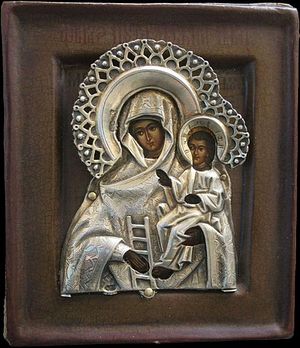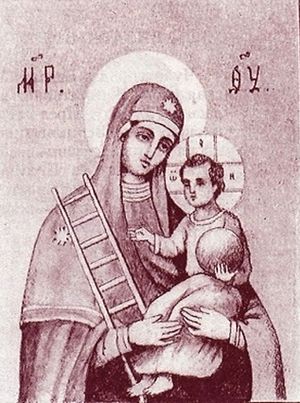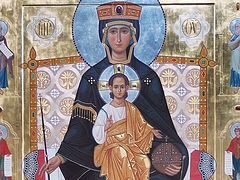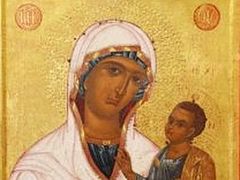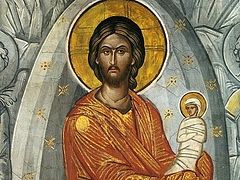The ancient town of Putivl was first mentioned as early as 1146 as an important fortress in Kievan Rus. After the Battle of Vedrosha in 1500, Putivl was ceded to Muscovite Russia. During the Time of Troubles, the town became the center of Ivan Bolotnikov's uprising and briefly a base for the False Dmitry I forces. It was occupied by Polish-Lithuanian Commonwealth between 1607 and 1619.1
Now a part of the Ukraine, Putivl is known among the faithful as a place of pilgrimage, thanks to the miraculous Hodigitria icon that appeared there.
Putivl was part of Kursk guberniya of the Russian Empire prior to the Bolshevik Revolution. It was part of Ukrainian SSR in 16 October 1925. During the Second World War Soviet partisans led by Sydir Kovpak started their guerrilla war against the Germans in the forests all over the Northern Ukraine. It was under German occupation between 10 September 1941 and 3 September 1943.
A detailed review of accounts contained in a variety of liturgical and historical documents regarding the Putivl Icon of the Mother of God leads to the conclusion that there were at least two icons bearing that name.
One was kept in the Putivl Molchensky Monastery, and another, in the Putivl Church of the Resurrection of Christ. A factor in confusing them as one was that each of the icons appeared on the city gates, but at different times: Various documents date the appearance of the icon to the years 1232, 1238, 1600 and 1635.
Details recorded in Abbot Manuel’s “Reports,” and inscribed on the shrine in which the Icon of the Mother of God in the Molchensky Monastery rested, state that at the first hour of the day, on May 2, in the year 7143 since the creation of the world and 1635 years since the Nativity of Christ, the Most-holy Theotokos Hodigitria [indicator of the path] appeared within the city of Putivl, at the front, Nikolsky [St. Nicholas], gates.
As to the second Putivl Icon, Fr. Jacob Levitsky, an early twentieth-century historian reported, “It was pleasing to God in His Divine Providence, that on May 2, 1600, on the eve of the Time of Troubles, the Indicator of the Path, the Mother of God, now in the Resurrection Church, should miraculously appear to this city, as the large and original icon of the Mother of God now in the Resurrection Church.” The following inscription, written in cinnabar pigment, appears on the back wall: “The year 7108, May 2, in the first hour of the day, [was] the appearance of the Honorable and Holy Hodigitria Icon of our Most-holy Theotokos and Ever-virgin Mary, in the city of Putivl, at the first city gates.” Documents dating to the time of the founding of that church described that icon as the “one [which] miraculously appeared.”
There exists evidence showing that for a long time, the Miraculous Icon of the Most-holy Theotokos was on the city gates, and was glorified by a multitude of signs and miracles.
By the intercession of the Theotokos through her Holy Icon, Putivl “more than once was spared in olden times from attacks by Tatar forces, and in recent years, by Swedes.”
During the times of militant atheism, the original icon, along with many other holy treasures of the Russian Orthodox Church, was lost. There remained only illustrations in pre-Revolutionary publications, where the Mother of God was depicted with the Pre-eternal Infant, holding an orb—a symbol of the Pantocrator [Christ the All-Soveriegn]—in His left hand. Behind the right hand of the Mother of God is a ladder, symbolizing the joining of the earthly with the Heavenly through the Nativity of the Savior. A similar depiction is found on the Molchensky Icon of the Most-holy Theotokos.
Despite the loss of the ancient icon, in our times Orthodox people continue to venerate the Putivl Icon of the Most-holy Theotokos. The flow of people, hearts filled with love and thanksgiving, continues without ceasing to the Putivl Holy Transfiguration Cathedral.
From Parish Life, A Monthly Publication of the Russian Orthodox Cathedral of St. John the Baptist Washington, DC, May 2017.

